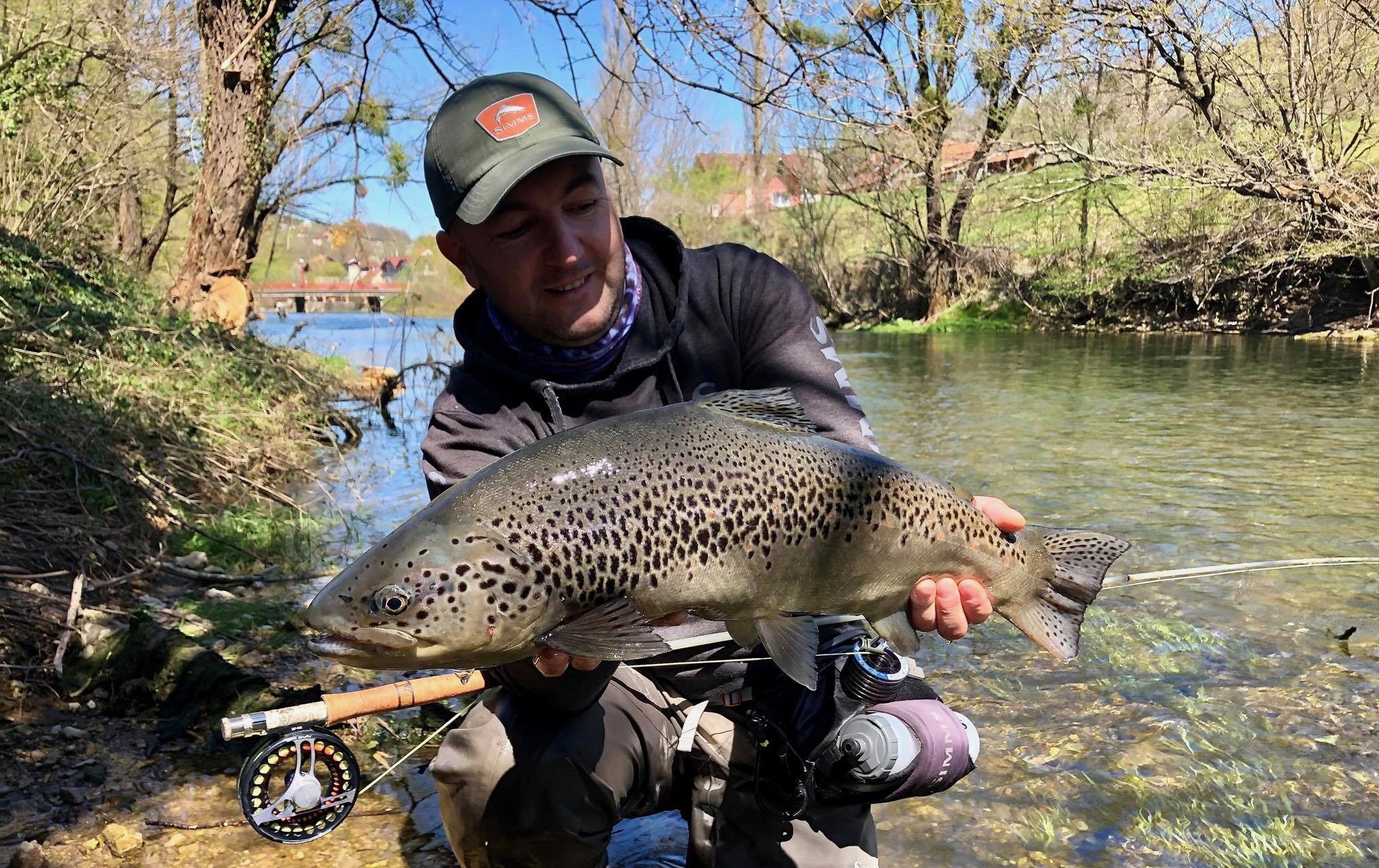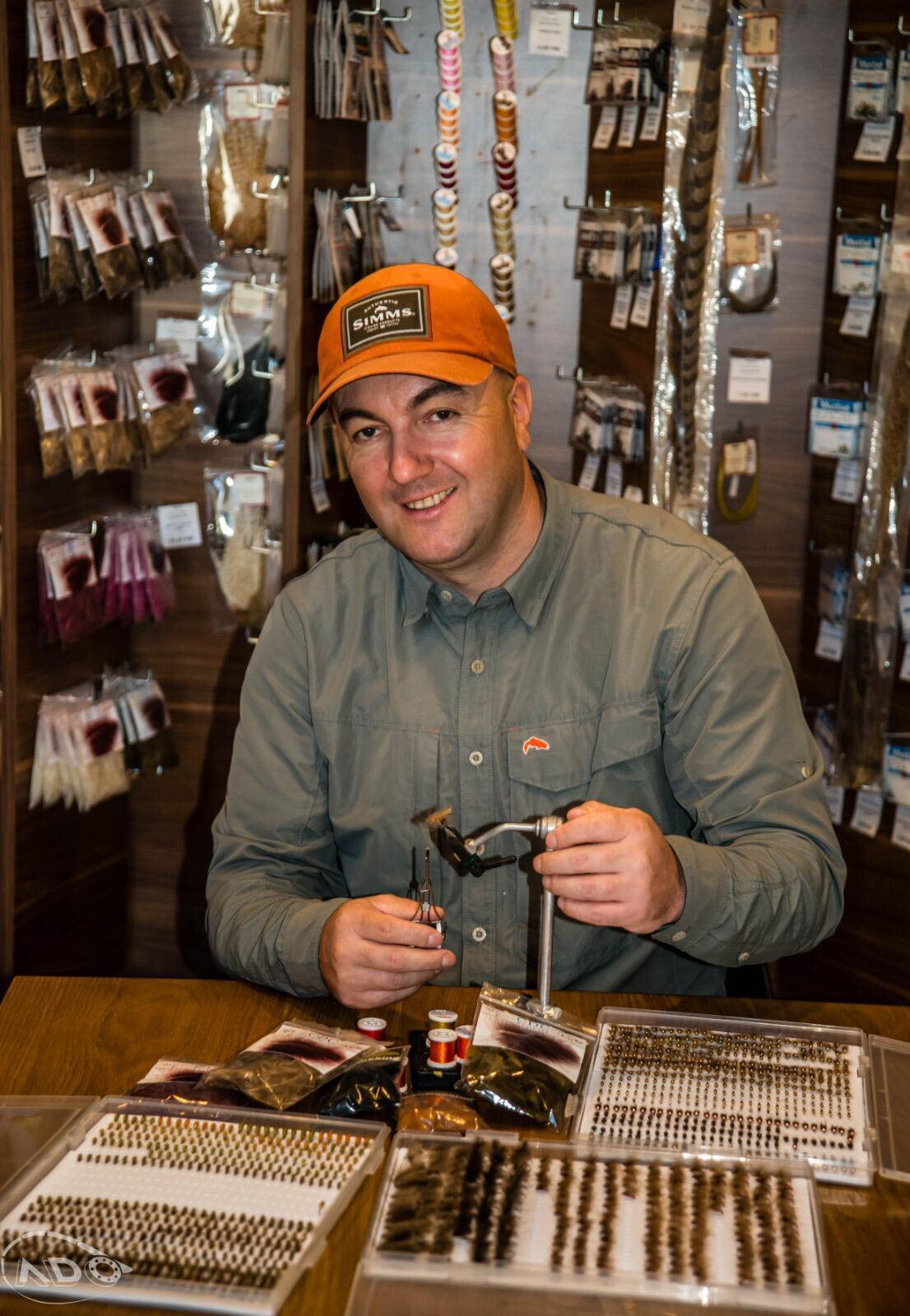
Admir Jeginovic
https://www.fishingbosnia.com/
1. Choice of equipment Rods, reels, fly lines, fly floatants, clothes, glasses and other useful items.
Mainly fish with my own handcrafted rods. If carbon, then it is Sage Trout LL, if glass then various glass blanks For reels I mainly fish waterworks lamson. Mainly I use Scientific Angler fly lines. Leaders, definitely Varivas, for me the best leader I ever used. Don't use strike indicators when nymphing, and the floatant for dry fly I use is Loon Lochsa. Glasses I barely use, but when I use then it is Smith or Costa, both available in my shop.
For dry fly I mainly use rods 7.6 to 8.6, #2 and #3. I like fishing dry flies with lightweight rods, rod action is not so important since I like both medium and fast action rods.
2. Leader material, build up, length and knots.
When it comes to leaders, I am hooked with VARIVAS, though not easy to find them here. I mainly use Varivas Airs leaders, but I also use the ones from Scientific Anglers. From tippets I use various ones, mainly Scientific Anglers and Stroft, but also Samurai, Varivas, etc. I mainly fish with standard 9ft leaders, and when necessary I extend the tippet materials. I use mainly Arbor, Surgeon's, Improved Klinch and Albright Special, actually I think these are the only knots I use.
3. Approach and stealth.
I prefer to come to the water and observe for 10-15 min, see the insect hatches, fish behaviour, check the water temperature and level and see around for a while before casting the fly. Usually I start fishing with long leaders and small nymphs, then first possibility I switch to dry fly which is my favourite fishing approach.
4. Reading the water.
For me reading the water is very important factor in fly fishing, especially when I fish new waters, but also when I fish the regular ones. I spend time checking water temperature, insect life, current, soil, vegetation, etc. I pay attention to water temperature and current as a combination, since the colder the water is the metabolism of fish gets lower causing the fish to fish less. In general, I try spotting fish based on two principles:
1. Current - fish will use the current for hiding from predators and also for feeding
2. Spot the feeding opportunities - for instance, sometimes fish beside the current they also hide close to the bank waiting for insects to fall down.
There is much about reading the water, but I guess the above is the most important to me.
5. Casting ability which casts are essential.
Casting is an important factor in flyfishing, especially when fishing dry flies. The main casting techniques that in my view every fisherman needs to know before going into the water are the Overhead Casting, Rollcast (extremely important for nymph fishing), and Switch Cast, but still overhead and rollcast I find them essential. It is important for casters to understand the energy needed to transfer for the cast, and also to be able to create the correct loop, for instance a D loop for rollcast.
6. Entomology, what should we know.
One of my favourite subjects in fly fishing is Entomology. Without an intention to offend anyone, I can accept a fly fisherman with bad casting techniques but I cannot accept one without any clue in entomology. It is essential that each fly fisherman at least knows the basics, learn the family of insects, and learn the life stages of those insects. If a fly fisherman doesn't understand the life stage of the insect, then he might have issues choosing the right pattern. I recommend to my students also to learn about the main insect families, at least those present in our waters in Bosnia and region, Midge, Mayfly, Scuds, Worms, Stonefly, Caddis and Terrestrial.
7. Rise forms Can they tell us something?
Well, before monitoring the rise I walk around to see if there are any insects flying, on the ground, tree branches etc. That is for me the first indicator what was hatching before. When I get the water, beside observing the water I also shake the tree branches and bushes around (if any) to see what insects will fall or fly away. That is the second indicator I get about the potential hatch. Then I observe the fish rise and insects. Fish always know what energy they need for grabbing the insect. When insects emerge fast, then fish rise will be accompanied by a splash. When insects are floating for a while, then gentle takes occur. When identifying the rise, one needs also to identify the insect, but also the type of rises if they are frequent, sporadic, etc. Often we have hatches of few insects simultaneously and this is when fisherman often get trapped with the choice of pattern. A net is also important for catching insects in the water. For instance, if the rises were mainly surface ones, one can look for midges, small spinners, etc., which will help to identify the correct pattern. When rises occur near the shore, then most likely it is an ant family we need to identify. In general, rises are very important segment of knowing how to fly fish with dry flies.
8. Fly selection, Size, shape, materials, which flies are essential.
Fly selection is dependent on what I described above, the water level, the insect life, insect life stages, river vegetation, soil, current, etc. Most of the fishing in our Bosnian waters is dry fly and nymphing. In most of the waters the hatches (except end May and June) are variations of midges and ants, therefore fishing is done with flies of sizes 18 to 24. I have a set of flies which never let me down in any country I fished, from Bosnia, Montenegro, Croatia, Slovenia, Austria, Germany, Switzerland and France. I usually fish with different CDC sedges, scuds, Ado's midges and emergers, big Stone flies (#8 and 10). From nymphs I use variations of pheasant tails and hair ear, and gammarus in different colours. I use also other nymphs, my own patterns, but the above are the most common ones. Materails I use are my own Ado Threads selections, CDC feathers, jungle cock, pheasant tail and various self-made (Ado's) dubbing. I especially like tying flies with some rare materials such as Australian Possum, Castor Rex rabbit, etc., materials I often use for making my own dubbing. I use TMC, Ahrex and Hends hooks. Dubbing, threads, body quill, body wires, various capes, I never buy, I have created my own brand which jealously I kept it for myself for a while, while now slowly I started also distributing to friends, and supplying a fishing shop in Switzerland with my fly tying materials and flies. The flies imitating the insect families mentioned above are essential, but few midges and ants, few caddis flies and few pheasant tail nymphs will always be in my box.
9. Presentation and drifts.
Presentation and drifts are essential for becoming a successful fisherman. For effective presentation, choosing the fish, placing the cast without spooking the fish and handling your fly line in the current making it look like real insect are crucial steps. One needs to learn how to imitate living insects with his fly rod in the hand and the chosen pattern. The most common drift I use is the dead drift. In the water usually the insects float and are served to the fish in a drift, hence dead drift is the most common. However, it is important to learn how to manipulate the drags which often occur when applying the dead drift. Mending is another drifting technique I practice a lot since it is important to re-position your line on the surface to counter the speed of drag caused by the current. The most important presentations for me are the upstream and downstream presentation, while for bigger rivers often I also use the cross-current presentation when presenting the fly to the other shore but with a fast current in the middle. It is interesting, but when fishing dry fly 90% of my presentations are downstream, not like many other fishermen I fished with. I find downstream presentation personally more effective, especially for drifting the fly in natural way. While when nymph fishing, I mainly use upstream presentation.
10. Upstream or downstream?
As explained earlier, I find downstream presentation personally more effective, especially for drifting the fly in natural way. While when nymph fishing, I mainly use upstream presentation.
11. Fighting fish.
Generally, I try to land the fish as fast as possible, always ensuring the balance between the line and the retrieve is thoroughly considered (not pull too hard and cut the fly/tippet, etc.). Important the use of landing nets with rubber nets, or if possible no landing net but release the fish in the water.







